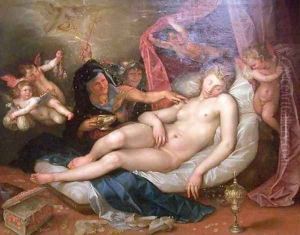Hendrik Goltzuis Paintings
Hendrik Goltzius was a German-born Dutch printmaker, draftsman, and painter. He was born in Mühlbracht (now part of Brüggen, North Rhine-Westphalia) in 1558. Goltzius is often considered one of the most important artists of the Dutch Golden Age, and he was renowned for his sophisticated technique and the exuberance of his compositions. Goltzius moved to the Netherlands at a young age, where he would spend the majority of his life and where his career flourished.
As a young man, Goltzius was taught by his father, Jan Goltz, a painter and glass designer. However, it was his move to Haarlem in 1576 that marked the true beginning of his career. In Haarlem, he became a pupil of the engraver Dirck Volckertsz Coornhert, who influenced him greatly. After Coornhert’s death, Goltzius took over his workshop and rapidly established himself as a master engraver.
Goltzius' reputation was built on his exceptional skill as an engraver and printmaker. He was particularly known for his ability to manipulate the burin with remarkable dexterity and for his use of swelling and tapering lines, a technique known as 'swelling line' engraving. This technique allowed him to create images with a rich variety of tones and deep contrasts between light and dark, which was innovative at the time and contributed to the dynamic quality of his work.
In addition to his prints, Goltzius also produced a number of drawings and paintings. His drawings were often elaborate and finished works of art in their own right. In the early 1600s, Goltzius took up painting, which was unusual for an artist who had achieved such fame as a printmaker. His paintings, like his prints, often depicted mythological and biblical scenes, characterized by their vigorous composition and lively handling of the subject matter.
One of his most significant contributions to art was his series of engravings depicting the lives of the saints and his illustrations of the ancient Roman gods, which were widely disseminated and highly influential. These works not only demonstrate his mastery of the engraving medium but also reflect the humanist interests of the period.
Goltzius had a profound influence on the artists of his time and on the development of Dutch art. He was not only a great artist but also a successful entrepreneur, leading a large workshop that trained many young artists, including his stepson Jacob Matham.
Hendrik Goltzius passed away on January 1, 1617, in Haarlem. His legacy lives on through his innovative techniques and the beautiful works he left behind, which continue to inspire and be studied by artists and art historians alike.
